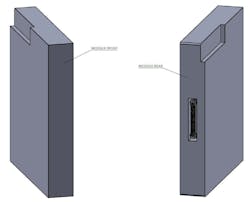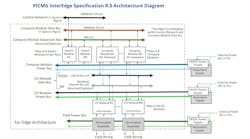At the end of February, PICMG (PCI Industrial Computer Manufacturers Group)—the consortium for open hardware specifications—introduced InterEdge, a modular architecture for process control systems that follows IEC 61499 and IEC 61131 standards. This new specification aims to provide an interoperable, multi-vendor solution for industrial PCs, programmable logic controllers and distributed control systems, offering flexibility and scalability to industrial manufacturers. This architecture divides hardware into compute modules, switch modules and I/O modules that are interconnected by a common backplane, making it easier to customize functions and expand automation.
With a vendor-neutral approach, InterEdge promotes a shared standard for edge computing and I/O module hardware, allowing the integration of various automation systems into a unified platform that is suitable for diverse industries, including automation, pharmaceuticals, oil and gas, and more. Hot-swappable interoperability eliminates vendor lock-in, simplifies upgrades and supports online maintenance, which should lead to cost savings.
Machine Design reached out to Steve Bitar, founding member of the PICMG InterEdge Working Group, to dig a little deeper into what InterEdge means for the design and engineering space. Here is the abridged Q&A:
Machine Design: What does this open standard mean for the multidisciplinary engineers who work in the machine design space?
Steve Bitar: The requirements of each machine or class of machine are unique, but the PICMG InterEdge specification gives the engineer/designer choices of capability and capacity to match the automation to the machine by offering optionality in the machine design space. The specification provides for interchangeability, allowing easy modifications to the automation components used, as a machine evolves by being upgraded or simplified.
The compute required is based on actual or planned workloads. A change in workloads can be easily managed by a change in compute modules, since they are interchangeable via the standard connector and interoperable with the I/O. The I/O is changeable and can be added or removed as needed.
The design engineer should consider component availability and supportability at the end-user’s location. With PICMG InterEdge, the choice of makes and models can be matched to marketplace offerings, with consideration to where the machine will live and who will support it.
MD: How does the standard for open modular process control systems ensure interoperability among different components in the machine design space?
SB: Every process control system has components providing computing to do the control calculations and I/O to interface to the sensors and actuation control devices. The PICMG InterEdge specification provides the basis for interchangeability of components and defines the unique common connectors for these components. The common connector is the standard physical interface required for interchangeability and allows for degrees of freedom in design when choosing components.
For example, the question of make/model is reduced to a much simpler selection of a set of devices having that standardized connector that meet the equal or better comparison for required capability. The same simpler criteria apply to the end-user looking to add, upgrade or replace a component as well.
Many technologies have adopted common, standardized interfaces to enhance openness and modularity, and the time has come for process control systems to do the same. The goal is to specify that a vendor claiming interchangeability of components in a process control system adheres to the PICMG InterEdge specification.
MD: How does the standard address scalability and flexibility in integrating new technologies within the framework of open modular PCSs for machine design applications?
SB: The PICMG InterEdge specification defines the common, standard physical interface for a component to be interchangeable. That interchangeability implies interoperability in communications with other components. The features and capabilities of the component are at the discretion of the supplier as they offer their product to the marketplace.
Computing Components
For computing components, the speed and type of processor CPU, the operating system, and the amount of memory and storage are specification items offered by the supplier, while providing the standards-based interface at the physical connector.
The same differentiation and inclusion of IP applies to I/O and network components as long as the associated standards-based physical connector is provided. This freedom to differentiate and stratify the product offerings gives the suppliers and the end-users scalability and flexibility to solve their process control system’s needs.
High-Frequency Data
Machine and deep learning algorithms have the potential to rapidly transform the industrial landscape. However, transferring large data streams to servers for centralized processing has always been a challenge due to bandwidth limitations, latency concerns and communication failures. These data collection limitations may hide useful information available in sensors, actuators, analyzers and cameras.
Moving high-performance computing to the edge places AI-powered applications closer to the equipment, where high-frequency data can be accessed, analyzed, aggregated and modeled. High-powered edge platforms can make autonomous decisions to support closed-loop control, optimization, equipment health monitoring and abnormal situation handling.
Local analysis of high-frequency data coupled with diagnostic tools have the potential to improve equipment performance and reliability. AI models developed locally can also be shared in a federated learning architecture to offer broader operational insights and to support rapid decision-making.
Without standards that enable interchangeability, industrial edge computer lifecycles tend to be extended, which may defer cost but will also incur lost opportunities. Having the ability to upgrade computational resources allows users to exploit new and emerging technologies at very low switching costs.
Interchangeability means older edge computers can be readily swapped for higher-powered CPUs, GPUs, FPGAs or ASICs—or to add additional layers of defense, including denial-of-service protection, trojan detection, vulnerability scanning or the latest TPM hardware security standard. Edge interchangeability also creates a more competitive marketplace and reduces the economic impact of product obsolescence through multi-vendor substitution.


